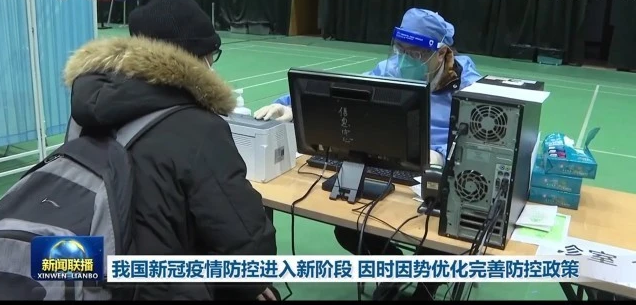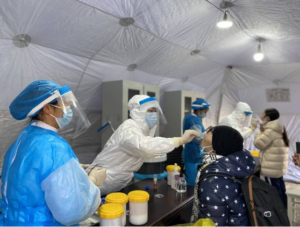
China’s epidemic prevention is pragmatic
Chinese officials announced in the evening of January 26th that the name of “novel coronavirus pneumonia” was changed to “novel coronavirus infection”, and announced that from January 8th, 2023, novel coronavirus infection will be changed from “Class B, Control A” to “Class B, Control B” according to the Law of the People’s Republic of China on the Prevention and Control of Infectious Diseases. It was also announced that from January 8, 2023, in accordance with the Law of the People’s Republic of China on the Prevention and Control of Infectious Diseases, the classification of novel coronavirus infections will be changed from “Category B A” to “Category B B”. At that time, China will no longer implement quarantine measures for people infected with the new coronavirus, no longer determine close contacts, no longer designate high- and low-risk areas, and no longer take quarantine infectious disease management measures for incoming persons and goods.

This is a further optimization of China’s epidemic prevention and control strategy, which is based on a comprehensive assessment of virus variation, epidemic situation, prevention and control experience, and adheres to the initiative of seeking truth from facts, scientific and precise optimization of epidemic prevention, following the principle of people first and life first.
At the beginning of the outbreak of the new crown epidemic, China included it in category B infectious diseases according to the relevant laws and adopted preventive and control measures for category A infectious diseases, with the aim of controlling the spread of the epidemic to the maximum extent through strict measures. In the past three years, China has developed nine versions of prevention and control programs and treatment protocols, which have successfully prevented the widespread prevalence of the relatively pathogenic original and delta mutant strains, greatly reducing serious illnesses and deaths, and also gaining valuable time for the development and application of vaccines, drugs, and the preparation of medical and other resources. China’s epidemic prevalence and number of disease deaths have remained at the lowest level in the world, with remarkable results in integrating economic development and epidemic prevention and control.
Currently, the world medical science community is of the opinion that the pathogenicity of the Omicron mutant strain is diminished and only a very small number of cases have pneumonia manifestations. China has renamed “new coronavirus pneumonia” to “new coronavirus infection”, which is more in line with the current disease characteristics and hazards; the new coronavirus infection has been adjusted to “category B, tube B”, which is more in line with the current epidemic situation. It is in line with the current situation of epidemic prevention and reflects the characteristics of epidemic prevention from the practical point of view and to the scientific method.
It is important to note that the adjustment to “Category B” is in no way a relaxation, but rather a shift of focus from “infection prevention” to “health protection and prevention of serious illnesses” to minimize the impact of the epidemic on economic and social development. It is to shift the focus from “infection prevention” to “health protection and prevention of serious illnesses” and minimize the impact of the epidemic on economic and social development. In the latest policy announcement, China has listed twelve measures to respond to the implementation of “Category B”, including further increasing the vaccination rate for the elderly, meeting the needs of patients for medication and testing, increasing investment in medical resources, and strengthening the prevention and control of epidemics in rural areas. These measures fully reflect the scientific and precise nature of the current epidemic prevention strategy in response to the risk of adjusting to the shift in gear.

Among them, the optimization of management measures for the movement of Chinese and foreign personnel has sparked extensive attention from foreign media. These measures include nucleic acid testing of incoming personnel 48 hours before their travel, elimination of full nucleic acid testing and centralized quarantine upon entry, etc. The Chinese government will also further optimize the arrangements for foreigners coming to China for resumption of work and production, business, study, family visits and reunions, and provide corresponding visa convenience; gradually resume passenger entry and exit at water and land ports; and orderly resume outbound tourism for Chinese citizens according to the international epidemic situation and the capacity of various services. This will make the movement of Chinese and foreign people more convenient, safe, orderly and efficient, and will also help to better coordinate epidemic prevention and control and economic and social development.
Since December, with the implementation of the “new ten” measures, the Chinese people have resumed smooth travel across the region. In Beijing, Shanghai and other major cities, restaurants, cinemas and other offline venues are opening one after another. From the eastern coast of Zhejiang and Jiangsu to the central and western Hunan and Sichuan, enterprises are busy resuming work and production, and cross-border investment is restarting. …… The long-lost “fireworks” are returning, witnessing the effectiveness of China’s better coordination of epidemic prevention and control and economic and social development. Morgan Stanley recently released the “2023 Global Macroeconomic Outlook” that the global economic growth next year, the overall lack of momentum, but the Asian economy is the most optimistic, China, India and other will lead the development of Asia.
The Central Economic Work Conference held not long ago proposed six “better coordination” of China’s economic work next year. The first of them is “better coordination between epidemic prevention and control and economic and social development”. It can be expected that, with the continuous implementation of China’s optimal epidemic prevention measures, China is well-equipped and capable of smoothly passing the current adjustment and gear-shifting period of its epidemic prevention strategy, protecting people’s lives and health to the greatest extent possible, and speeding up the recovery of economic and social order. This is obviously good news for the world economy, which is in the doldrums.


Average Rating